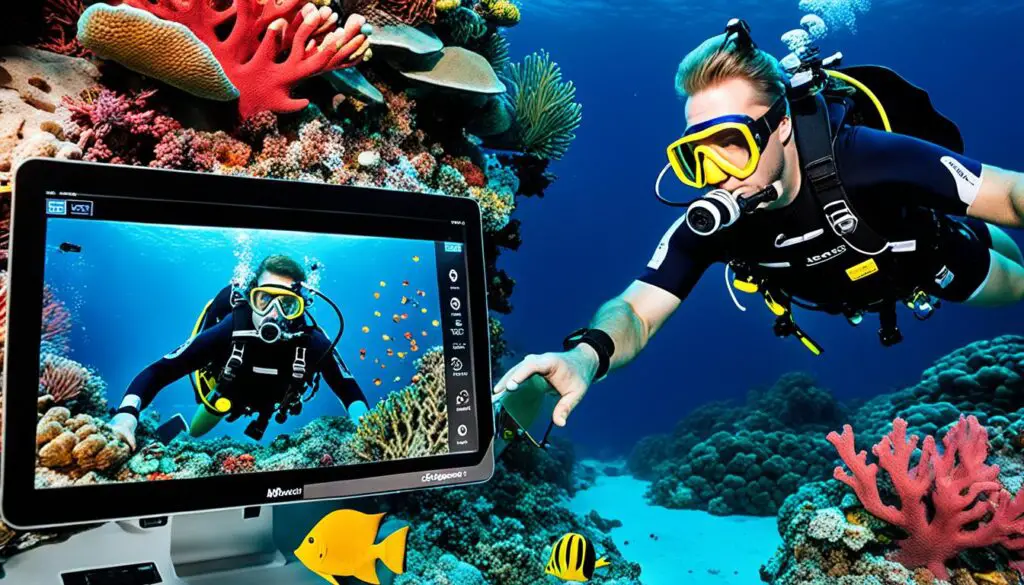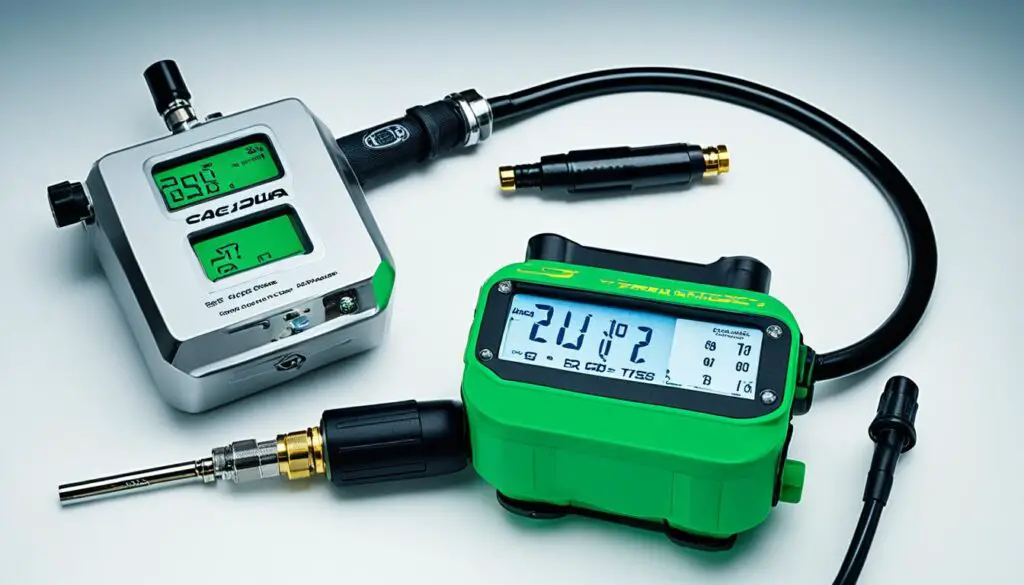Air integration in dive computers is very helpful for divers. It lets them see all key information in one place. This includes depth, no-deco time, and how much air is left. There are console dive computers and hoseless systems with a transmitter for air integration.
Console dive computers have big, clear displays and great value. But, they can be hard to see when doing other things. They also need battery changes.
Hoseless systems with a transmitter offer a display on the wrist. This makes it easy to check dive info without using hands. However, it needs an extra battery. Also, the display might be small for some divers. It does cut down on hoses and can figure out how much air is left.
Air integration does a lot for divers. It makes diving easier, keeps them informed, and simplifies their gear. This improves the whole diving adventure.
Key Takeaways
- Air integration in dive computers puts all important information in one spot.
- Two main kinds are console dive computers and hoseless systems with a transmitter.
- Consoles have big displays and good value. Hoseless systems have wrist displays for easy checking.
- Air integration means fewer hoses and helps figure out air needs better.
- Overall, it makes diving more convenient and aware by centralizing data.
Air Integrated Console Dive Computers
Air-integrated console dive computers have changed how we dive. They make it easier to see and understand dive info. They do this by showing everything on one screen. This means the old pressure gauge isn’t needed anymore.
Now, divers can quickly check their depth, dive time left, and air supply. They see this on their console dive computer. It’s all in one spot, so they don’t have to check different gauges. This makes diving easier and safer.
These computers also have cool extra features. Like, a digital compass, tracking how much air you’re using, and telling you how long your air will last. These features help divers navigate and track their air better.
But there are some downsides. It can be hard to check the screen while doing other things underwater. Divers sometimes have to stop and focus on the screen. This might not work well in all dive situations.
Changing the battery can be another issue. If the battery isn’t easy to replace, divers might have to wait for a service. This can disrupt their plans or cost them more money.
However, the benefits usually win over the issues for divers. Having all the important info in one place is a huge plus. These consoles are very popular because they make diving more enjoyable and safer for everyone.
Example Air Integrated Console Dive Computer Comparison:
| Features | Advantages | Disadvantages |
|---|---|---|
| Easy-to-read display | The large screen allows for effortless viewing of dive information. | Reading the display while multitasking can be challenging. |
| Additional features | Digital compass, air consumption tracking, and remaining air time calculation offer enhanced functionality. | Potential issues with battery changes if the battery is not user-replaceable. |
| Convenience | All critical dive information in one place, eliminating the need for multiple gauges. | Checking the display can be distracting during certain dive activities. |

Air Integration Using a Transmitter
Hoseless air integration involves a transmitter in dive computers. This method attaches a transmitter to the first stage. Then, it shows dive information on a wrist device. It has many benefits for divers.
Benefits of Air Integration Using a Transmitter
A big plus is seeing dive data without checking gauges. This helps when you’re busy with equipment underwater. You can track your depth and air without touching any additional gear.
It also cuts down on hose clutter. Before, divers had many hoses connected to their gear. But now, one less hose is needed, making the setup cleaner.
Plus, you can add the transmitter later. This is handy if you first get a dive computer without air integration. You can upgrade your gear anytime.
Drawbacks of Air Integration Using a Transmitter
Yet, there are some cons to using a transmitter. You always have to keep an eye on its battery. Forgetting to charge it could lose you dive time information.
Reading the display might be hard for some. If you have poor eyesight or wear glasses, check if the display works for you before diving.
Sometimes, transmitters might mix up data on busy boats. This could lead to wrong air supply info. But, technology is improving to reduce these issues.
Air integration using a transmitter is popular for its practical benefits. Despite having to manage another battery and checking the display’s suitability, it’s a strong choice. Divers love being able to see key dive info easily while reducing hose mess.

| Benefits of Air Integration Using a Transmitter | Drawbacks of Air Integration Using a Transmitter |
|---|---|
| Ability to view critical dive data when hands are occupied | Need to remember to charge or replace an extra battery |
| Reduced clutter from fewer hoses | Small digits on the display can be hard to read for long-sighted divers |
| Option to add the transmitter later for added convenience | Occasional issues with transmitters getting confused on busy dive boats |
Conclusion
Air integration in your dive computer brings many advantages. It’s a must-have tool for divers. You can pick an air-integrated console or go hoseless with a transmitter. Either way, all your key dive data is in one place. This makes diving simpler by combining your air status with other important info like depth and time limits.
Some issues exist, like reading screens while busy and needing extra batteries. However, the benefits of air integration are greater. It means less gear to deal with since you don’t need extra hoses. Plus, it’s safer and more convenient. You get key dive info without needing multiple gadgets.
Overall, adding air integration to your dive computer is a wise choice. It lets you easily access vital dive details. This is helpful for all divers, from those who do it for fun to the pros. With air integration, diving becomes safer, more efficient, and more fun.
FAQ
What are the benefits of air integration in dive computers?
Air integration makes dive computers display all vital dive data in one spot. This data includes depth, no-deco time, and how much air is left.
What are air-integrated console dive computers?
These dive computers show important dive info on a big screen. They’re easy to read and also have neat extras like a compass.
What are the advantages and disadvantages of air-integrated console dive computers?
The pros of these computers are how easy they are to use and their extra features. But, they can be hard to glance at while busy. Also, swapping the battery can be tricky if it’s not user-replaceable.
How does air integration using a transmitter work?
You connect a transmitter to your dive tank and read info on your wrist. This way, you always know your air and dive details, even hands-free.
What are the benefits and drawbacks of air integration using a transmitter?
Using a transmitter means less hoses and more situational awareness. Yet, you must keep an eye on the battery. The small numbers on the wrist display might be hard to see for some.
Why should I choose air integration in dive computers?
It keeps all dive data in one spot, making diving easier and safer. Even with a few challenges, the benefits are great for most divers.
